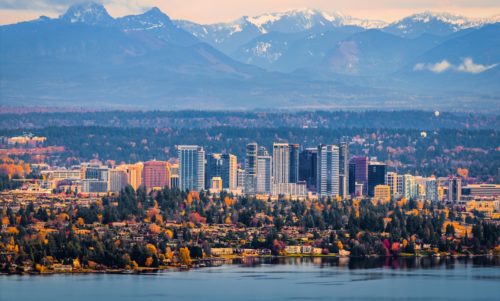Bellevue Washington. The snowy Alpine Lakes Wilderness mountain peaks rise behind the urban skyline.

Washington Clean Buildings Bill Raises the Bar for Every State
Buildings are at the forefront of climate action in the state of Washington, spurred by Seattle’s recent adoption of an energy code that will require new large buildings to be fossil fuel free. Now legislators are considering an ambitious new bill stemming from Governor Jay Inslee’s comprehensive climate proposal.
The Healthy Homes and Clean Buildings Act seeks to cut building emissions in line with the state’s climate goals by winding down the gas system and transitioning to clean, electric alternatives. It is also the most comprehensive legislation to date in the United States aimed at getting fossil fuels out of buildings and has significantly raised the level of ambition on what might be possible for other states.
The Washington bill proposes a wide range of innovative policies that would dramatically reduce climate pollution from the state’s buildings. What differentiates this bill from efforts in other states is that it attempts to systemically address electrifying buildings through a comprehensive set of policy levers. These policies fall into three major categories: stop the expansion of the gas system, plan for systems retirement, and ensure that the transition equitably benefits frontline communities and workers. These policy levers are not unique to the state, meaning that advocates all over the country can and should consider the approaches proposed, adapt them to local circumstances, and try to pass similar bills that also systemically support building electrification.
Stop Expanding a Failing System
A key aspect of the act is to stop the expansion of the gas system. To accomplish this most directly, the act removes the ability for a utility to offer new service to customers outside of existing service territories as of July 1, 2021. This would essentially freeze the expansion of the gas system into new geographic areas immediately.
Stopping the expansion of gas infrastructure is important because utilities should not invest in assets that have 50-plus-year amortization lives. Those assets are bad for investors and bad for ratepayers—instead, utilities need to invest in assets that will be climate-ready, like energy services. This facet of the bill aligns with the Washington 2021 State Energy Strategy, which recommends that the state “explore legislative and regulatory actions to restrict growth of the natural gas system” to reduce the risk of stranded assets as the state transitions off gas.
In addition to stopping the system expansion beyond its current area, the act also helps to support climate alignment for utility ratepayers and investors. Utilities would no longer have to furnish gas to customers if requested, as is required under current law, which prevents utilities from internally setting policies to stop the expansion of the gas system. Instead, the bill focuses on “energy services,” requiring utilities to “reduce the use of fossil fuels for space and water heating.”
The act also seeks to update the state energy code for new construction to require all-electric space and water heating by 2027 and zero-emissions buildings by 2030. Although the proposed dates could be more aggressive, these code changes would make Washington the first state in the country to set a firm date on requiring new buildings to be decarbonized. Recent research from RMI has indicated that this strategy is cost-effective and will reduce emissions of new homes by up to 93 percent.
Current law in Washington blocks cities from enacting more ambitious energy codes than the state code provides for residential buildings. This prevents Washington cities from applying a key tool used by over 40 cities in California since 2019 to push forward on residential building decarbonization. The act would allow cities to accelerate the implementation of all-electric residential building by creating a statewide all-electric reach code that cities could adopt into their local energy codes ahead of the 2027 and 2030 statewide energy code cycles.
Plan for Retirement
As Washington State’s analysis has shown, transitioning off gas is a crucial part of the most cost-effective strategy to reach the state’s 2050 climate goals. The act requires utilities to develop transition implementation plans that evaluate and compare multiple strategies to achieve the state’s greenhouse gas emissions targets. These strategies must include ideas such as the targeted retirement of the natural gas system, helping existing gas customers—especially those from low-income households—to switch to high-efficiency electric appliances, and reducing energy loads by increasing building envelope efficiency.
Importantly, the utilities will need to take specific actions to achieve these strategies. Utilities must also estimate the total cost and benefits of these actions, including incorporating the avoided social cost of greenhouse gas emissions from the use of gas.
The act also requires new customers to pay for the full cost of gas-line extensions for new service, rather than passing that cost on to all ratepayers. Washington currently lets utilities pay developers a rebate of up to $4,300 when they add a new gas line to a building and transfer that cost onto all gas customers through their utility bills. As RMI analysis has explained, these payments provide a major subsidy for gas buildings and artificially decrease their upfront construction costs. The act will close this loophole and eliminate the subsidy for gas buildings, increasing the cost savings for all-electric buildings.
The act also proposes changes to utilities’ accounting and billing practices to more accurately reflect the need to transition off the gas system. Currently, for billing purposes, utilities can treat their new gas infrastructure as if it will be in operation for many decades. This depreciation accounting schedule contributes to keeping gas rates low but does not realistically reflect the need to transition off the gas system. The act remedies this issue by requiring utilities to design their accounting and billing practices to align with the timing of the gas phaseout reflected in their transition implementation plans.
Focus on Workers and Frontline Communities
With legislation this transformative, it is crucial to ensure that the impacts of the policies are equitable. Under the proposed legislation, utilities must:
- include in their transition implementation plans an estimate of the costs and benefits for vulnerable and overburdened communities,
- ensure that those communities get an equitable share of the benefits from the utility programs created under those plans,
- and design the programs to improve indoor air quality, especially for disadvantaged communities.
Recognizing that utilities will need funding to help realize their transition implementation programs, the act also establishes a carbon surcharge to help fund their actions. The carbon surcharge is equal to the social cost of carbon used during the transition implementation planning process and is collected as a tariff by each utility.
Additionally, the funds collected through the carbon surcharge will be used to ensure that projects have high labor standards and avoid worker dislocation by providing job training programs for fossil fuel workers affected by the transition. The carbon surcharge will also be used to provide weatherization services, bill credits, or rate assistance to low-income customers, including assistance to offset the impacts of the uniform climate protection surcharge.
A Blueprint for Other States
Other states should take note that many aspects of the Healthy Homes and Clean Buildings Act can and should be replicated anywhere. The policies laid out in this act are vital tools for helping any state to decarbonize its buildings effectively, efficiently, and equitably. Whether it is requiring all-electric buildings in statewide energy codes, eliminating gas-line-extension allowances, or collecting a climate surcharge to help pay for the transition, the Healthy Homes and Clean Buildings Act is now the nation’s leading example in building decarbonization policy.
If Washington adopts this act, it will be a significant step forward on creating cleaner and healthier buildings for all. It is time for other states to follow—and build on—Washington’s lead.


